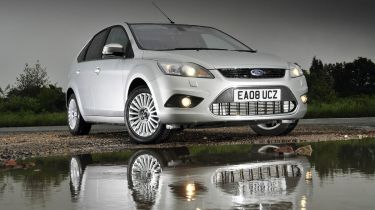Ford Focus Powershift
Ford joins the hi-tech dual-clutch automatic gearbox brigade with its Powershift-equipped Focus.

Ford’s first attempt at a dual-clutch transmission has come late, but perhaps all that extra development time has paid off – because the Focus Powershift is a truly impressive effort. By combining the point-and-go ease of a traditional automatic box with the performance, fuel economy and emissions of a manual, many will find the Powershift the perfect fit. The only drawbacks are the lack of a Sport mode – and that price!
It's all change at Ford! Not only has the firm facelifted its top-selling Focus, but it’s also launched a flagship diesel version of the family hatch fitted with an innovative automatic gearbox.
The six-speeder is called Powershift, and is a rival to the likes of the Volkswagen DSG. Linked to a diesel engine, it’s being hailed for the environmental and financial advantages it provides over a conventional automatic box.
Powershift works by operating two clutches in parallel: one handles the odd gears (one, three and five), and the other even ratios (two, four and six). This allows the transmission to pre-select the upcoming gear, meaning a smooth, almost instant change, with no loss of torque in each shift.
On paper, the newcomer certainly looks promising. It delivers 320Nm of torque to the front wheels from only 2,000rpm, while a further 20Nm is available thanks to a temporary over-boost function. That’s enough to see the 134bhp Focus Powershift complete the sprint from 0-62mph in 9.6 seconds, while averaging economy of 48.6mpg on the combined cycle and emitting 154g/km of CO2.
Its vital statistics aren’t quite as strong as those of a standard manual Focus – which has a 9.4-second sprint time, returns 50.4mpg and puts out only 147g/km. However, the differences are negligible, which is pretty impressive for an automatic model.
The Powershift transmission is currently only available with this 134bhp 2.0-litre TDCi diesel and the less powerful 108bhp variant, and can be specified solely in the hatchback version of the Focus, as well as the C-MAX compact MPV. However, Ford tells us the set-up will be rolled out to other cars in the range before long.
On the road, it behaves similarly to a conventional auto – albeit a very good one – changing between gears quickly and smoothly. But the system really comes into its own under acceleration, gliding from ratio to ratio with impressive speed and accuracy.
Even when shifting down we were unable to catch it out. The box always selected the most appropriate gear without any hesitation or jerkiness.
Adding to the appeal is an intuitive manual mode, for drivers who want greater involvement. A red light on the Focus’s rev counter indicates the optimum time to change gear, and you simply pull the lever back to shift up. It’s easier to operate than DSG, which uses the stick the opposite way.
But there are no steering wheel-mounted paddleshifters with which to change up or down – and no Sport mode on the box, either – as Ford is keen to stress the gains in economy and emissions offered by Powershift, rather than its outright sportiness. Still, neither of these features is really necessary, because the lever is likely to spend most of its time in ‘D’, allowing the auto to make the most of the engine’s relaxed, torquey nature.
The combination of the clever new gearbox and punchy diesel performance with the Focus’s class-leading driving dynamics makes the Power-shift model a compelling package. But buyers pay for the privilege. The five-door Titanium-spec model we drove costs in excess of £20,000 – that’s more than the latest range-topping Focus ST.
So, we’re reassured to hear that in time Ford will make Powershift more widely available on cheaper, entry-level models. Now that really will be a change for the better.
Rival: VW Golf 2.0 TDI DSG
GERMAN giant led the way by filtering its dual-clutch technology down from performance versions of the Golf to lesser models such as the 2.0-litre TDI diesel. And the six-speed DSG transmission continues to set the benchmark by which rival systems are judged.







